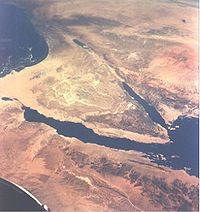Great Rift Valley: Difference between revisions
| Line 33: | Line 33: | ||
* [[Horst (geology)]] |
* [[Horst (geology)]] |
||
* [[Galilee earthquake of 1837]] |
* [[Galilee earthquake of 1837]] |
||
| ⚫ | |||
* [[Rift Valley lakes]] |
* [[Rift Valley lakes]] |
||
| ⚫ | |||
* [[:Category:Volcanoes of the Great Rift Valley]] |
* [[:Category:Volcanoes of the Great Rift Valley]] |
||
Revision as of 19:03, 29 January 2010

The Great Rift Valley is a name given in the late 19th century by British explorer John Walter Gregory to the continuous geographic trench, approximately 6,000 kilometres (3,700 mi) in length, that runs from northern Syria in Southwest Asia to central Mozambique in East Africa. The name continues in some usages, although it is today considered geologically imprecise as it combines features that are today regarded as separate, although related, rift and fault systems. Today, the term is most often used to refer to the valley of the East African Rift, the divergent plate boundary which extends from the Afar Triple Junction southward across eastern Africa, and is in the process of splitting the African Plate into two new separate plates. Geologists generally refer to these incipient plates as the Nubian Plate and the Somali Plate.
Geography


The Great Rift Valley as originally described extends from Lebanon in the north to Mozambique in the south, and constitutes one of two distinct physiographic provinces of the East African mountains physiographic division. The northernmost part of the Rift, today called the Dead Sea Transform or Rift, forms the Beqaa Valley in Lebanon separating the Lebanon Mountains and Anti-Lebanon Mountains. Further south it is known as the Hula Valley separating the Galilee mountains and the Golan Heights. The River Jordan begins here and flows southward through Lake Hula into the Sea of Galilee in Israel, then continues south through the Jordan Rift Valley into the Dead Sea on the Israeli-Jordanian border. From the Dead Sea southwards, the Rift is occupied by the Wadi Arabah, then the Gulf of Aqaba, and then the Red Sea. Off the southern tip of Sinai in the Red Sea, the Dead Sea Transform meets the Red Sea Rift which runs the length of the Red Sea. The Red Sea Rift comes ashore to meet the East African Rift and the Aden Ridge in the Afar Depression of East Africa. The junction of these three rifts is called the Afar Triple Junction.
In eastern Africa, the valley divides into two, the Northern Rift Valley and the Southern Rift Valley.
The Western Rift, also called the Albertine Rift, is edged by some of the highest mountains in Africa, including the Virunga Mountains, Mitumba Mountains, and Ruwenzori Range. It contains the Rift Valley lakes, which include some of the deepest lakes in the world (up to 1,470 metres deep at Lake Tanganyika). Much of this area lies within the boundaries of national parks such as Virunga National Park in the Democratic Republic of Congo, Rwenzori National Park and Queen Elizabeth National Park in Uganda, and Volcanoes National Park in Rwanda. Lake Victoria, the second largest area freshwater lake in the world, is considered part of the Rift Valley system although it actually lies between the two branches. All of the African Great Lakes were formed as the result of the rift, and most lie within its rift valley.
In Kenya, the valley is deepest to the north of Nairobi. As the lakes in the Eastern Rift have no outlet to the sea and tend to be shallow, they have a high mineral content as the evaporation of water leaves the salts behind. For example, Lake Magadi has high concentrations of soda (sodium carbonate) and Lake Elmenteita, Lake Bogoria, and Lake Nakuru are all strongly alkaline, while the freshwater springs supplying Lake Naivasha are essential to support its current biological variety.
Discoveries in human evolution
The Rift Valley in East Africa has been a rich source of fossils[1] that allow study of human evolution, especially in an area known as Piedmont.[2]
Because the rapidly eroding highlands have filled the valley with sediments, a favorable environment for the preservation of remains has been created. The bones of several hominid ancestors of modern humans have been found there, including those of "Lucy",[3] a partial, yet eye opening australopithecine skeleton, which was discovered by anthropologist Donald Johanson dating back over 3 million years. Richard and Mary Leakey have also done significant work in this region.
More recently, two other hominid ancestors have been discovered there: a 10 million year-old ape called Chororapithecus abyssinicus, found in the Afar rift, in eastern Ethiopia,[4] and the Nakalipithecus nakayamai, which is also 10 million years old.[4]
See also
- Graben
- Horst (geology)
- Galilee earthquake of 1837
- Great Rift: Africa's wild heart (TV series) A BBC/Animal Planet production
- Rift Valley lakes
- Category:Volcanoes of the Great Rift Valley
Notes
- ^ "Great Rift Valley Ecosystem - UNESCO World Heritage Centre". whc.unesco.org. Retrieved 2008-03-14.
- ^ "Great Rift Valley - Everything on Great Rift Valley (information, latest news, articles,...)". www.spiritus-temporis.com. Retrieved 2008-03-14.
- ^ "Ethiopian Rift Valley Safaris - Homepage". www.ethiopianriftvalleysafaris.com. Retrieved 2008-03-14.
- ^ a b Seward, Liz (2007-08-22). "BBC NEWS". news.bbc.co.uk. Retrieved 2008-03-14.
{{cite web}}: Text "Fossils belong to new great ape" ignored (help); Text "Science/Nature" ignored (help)
Further reading
- Africa's Great Rift Valley, 2001, ISBN 0810906023
- Tribes of the Great Rift Valley, 2007, ISBN 9780810994119
- East African Rift Valley lakes, 2006, OCLC 76876862
- Photographic atlas of the Mid-Atlantic Ridge Rift Valley, 1977, ISBN 0387902473
- Rift Valley fever : an emerging human and animal problem, 1982, ISBN 9241700637

